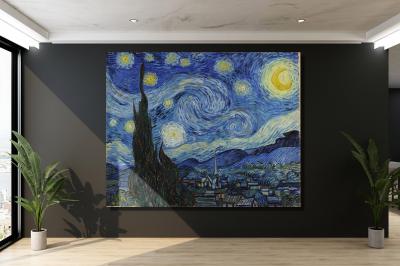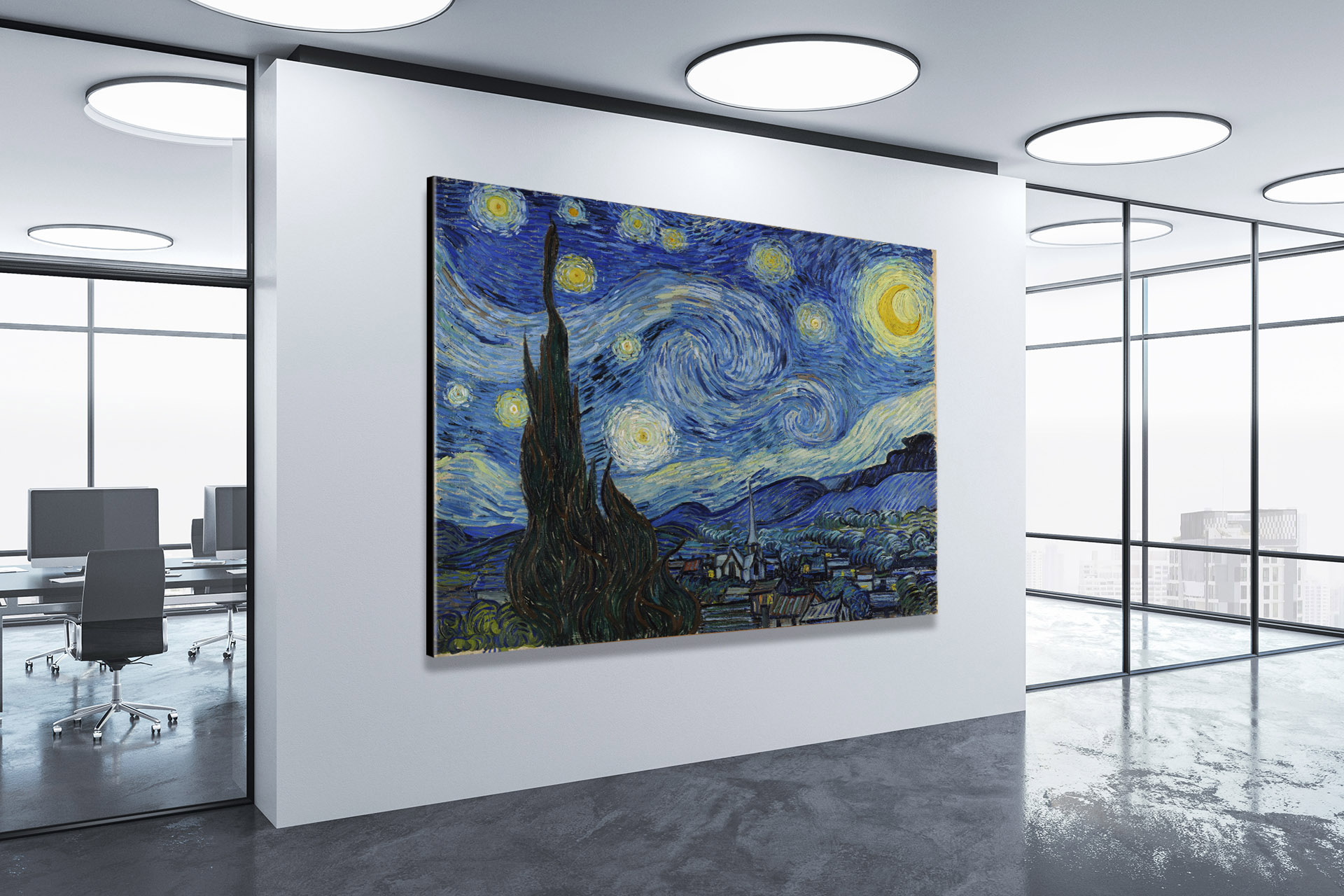Starry Night
By Vincent van Gogh, 1889
“Starry Night” by Vincent van Gogh: An Odyssey Through the Cosmic Canvas and Technical Marvel
Few paintings in the annals of art history command as much attention and ignite the imagination as Vincent van Gogh’s “Starry Night.” This celestial masterpiece, created in 1889 during van Gogh’s stay at the Saint-Paul-de-Mausole asylum in Saint-Rémy-de-Provence, France, remains a profound testament to the artist’s ability to channel his inner turmoil and profound connection with the cosmos onto the canvas. In this extended exploration, we venture into the world of “Starry Night,” unveiling its enigmatic mysteries, multifaceted symbolism, the technical challenges van Gogh faced in its creation, and a detailed look at the painter himself, all against the backdrop of its unique location.
A Portrait of Madness and Tranquility
“Starry Night” encapsulates the dichotomy of madness and tranquility at the heart of Vincent van Gogh’s tumultuous life. Painted during a turbulent period marked by mental anguish and isolation within the walls of the asylum, the painting mirrors the artist’s own inner turmoil, where the turbulent and the tranquil coexist in harmonious discord.
“Starry Night” encapsulates the dichotomy of madness and tranquility at the heart of Vincent van Gogh’s tumultuous life. Painted during a turbulent period marked by mental anguish and isolation within the walls of the asylum, the painting mirrors the artist’s own inner turmoil, where the turbulent and the tranquil coexist in harmonious discord.
“Starry Night” Large Canvas Prints from WhiteClouds
The Location
The choice of Saint-Rémy-de-Provence as the location for the creation of “Starry Night” is not incidental. The village and its surroundings provided van Gogh with a rich tapestry of inspiration. The landscapes of Provence, with their rolling hills, cypress trees, and starlit skies, served as a wellspring of creativity, infusing his work with the essence of the region.
The Composition
“Starry Night” presents itself as a picturesque French village beneath a celestial sky at first glance. However, it transcends the boundaries of reality, inviting viewers into a world where the ordinary converges with the surreal. The village, illuminated by warm, golden hues, seems to be both nestled beneath and consumed by the cosmic tumult swirling above, blurring the lines between the earthly and the ethereal.
The Starry Sky
Van Gogh’s interpretation of the night sky in “Starry Night” goes beyond mere representation. It is a profound emotional and spiritual expression, transcending astronomical accuracy. The sky is a swirling maelstrom of blues, deep indigos, and radiant yellows, a cosmic tempest with luminous stars and a crescent moon. The tumultuous swirls and bold strokes evoke a sense of cosmic turbulence and transcendence, encouraging viewers to lose themselves in the boundless expanse of the universe.
Technical Challenges
The creation of “Starry Night” was not without its technical challenges. Van Gogh employed a technique known as impasto, where paint is applied in thick layers to create texture and depth. The impasto technique posed a challenge due to the restricted access to art supplies in the asylum. Van Gogh ingeniously used unconventional materials, such as cardboard, to experiment with texture and layering, creating a tactile quality that adds to the painting’s allure.
The Village and Cypress Tree
The quiet village below the celestial spectacle stands in stark contrast to the cosmic chaos above. The quaint houses, their warm, inviting colors basking in the celestial glow, provide a sense of stability and connection amidst the swirling cosmic maelstrom. Rising above the village, the cypress tree’s dark silhouette extends toward the heavens, acting as a bridge between the terrestrial and the celestial. Some art historians suggest that the cypress tree symbolizes the artist himself, reaching for the cosmic heights.
The Symbolism
“Starry Night” is a tapestry woven with symbolism, revealing van Gogh’s profound emotional and philosophical contemplations. The swirling stars are a visual representation of the tumult within the artist’s mind, while the village symbolizes his yearning for stability and human connection amidst the chaos of his existence. The radiant stars, in some interpretations, represent hope and spiritual enlightenment in the face of life’s uncertainties.
Vincent van Gogh: The Painter and His Turbulent Genius
Vincent van Gogh, born in the Netherlands in 1853, led a life that was as tumultuous as his art. His early years were marked by a series of vocations, including work as an art dealer and a teacher, before he dedicated himself fully to art in his late twenties. Van Gogh’s mental health began to deteriorate during this period, leading to bouts of depression and anxiety that would persist throughout his life.
One of the most distinctive aspects of van Gogh’s artistic journey is the rapid evolution of his style. He transitioned from the dark and earthy tones of his Dutch Realism-inspired works, such as “The Potato Eaters,” to the vibrant, expressive colors and bold brushwork of his later pieces, including “Starry Night.”
Despite battling mental health issues and financial hardships, van Gogh produced an astounding body of work, creating over 2,000 artworks in just a decade. His determination to convey the human condition and his deep empathy for the working class and the downtrodden manifested in his paintings, making them not only technically remarkable but emotionally resonant as well.
Vincent van Gogh’s life tragically came to an end on July 27, 1890, when he took his own life at the age of 37. Despite the challenges and suffering he endured, his legacy endures as one of the most influential and celebrated figures in the world of art. His contributions to the evolution of modern art, characterized by his bold use of color, dynamic brushwork, and emotional intensity, continue to inspire and captivate art lovers and creators across the globe.
 Starry Night by Vincent van Gogh
Starry Night by Vincent van Gogh
Conclusion
“Starry Night” by Vincent van Gogh is not merely a painting; it is an odyssey through the realms of the cosmic and the human spirit. Its timeless allure reminds us that even in the darkest of nights, there exists a luminous beauty waiting to be discovered. As we immerse ourselves in the swirling stars and the tranquil village below, we are transported into the very essence of van Gogh’s soul. The technical challenges he overcame to manifest this masterpiece, combined with the unique location of its creation, add layers of depth to the painting’s enduring legacy, where the dichotomy of chaos and serenity creates a profound, enduring masterpiece that transcends time and space. Vincent van Gogh’s turbulent life and artistic genius serve as a poignant reminder of the enduring power of creativity and the human spirit’s capacity to find beauty in the midst of adversity.
Frequently Asked Questions About “Starry Night”
Q: What is the meaning or symbolism behind “Starry Night”?
A: The meaning and symbolism of “Starry Night” have been subjects of debate among art scholars. Some suggest it reflects van Gogh’s turbulent emotions, while others see it as a representation of his spiritual connection with the universe.
Q: When and where was “Starry Night” painted?
A: Vincent van Gogh painted “Starry Night” in June 1889 while he was a patient at the Saint-Paul-de-Mausole asylum in Saint-Rémy-de-Provence, France.
Q: What inspired Vincent van Gogh to create “Starry Night”?
A: The inspiration for “Starry Night” came from the view outside van Gogh’s window at the asylum, which included a cypress tree and a swirling night sky. His emotional state and fascination with the night sky played a significant role in its creation.
Q: What is the style or artistic movement of “Starry Night”?
A: “Starry Night” is often associated with the Post-Impressionist movement, characterized by vivid colors, emotional expression, and a departure from strict realism.
Q: What are the key elements and features of the painting?
A: The key elements of “Starry Night” include the swirling sky, bright stars, a cypress tree, a small village, and a church steeple. The use of bold colors and thick, swirling brushwork is also noteworthy.
Q: What colors were used in “Starry Night,” and what do they represent?
A: The painting features vibrant blues, yellows, and greens. Some interpretations suggest that the blue represents depression and the yellow symbolizes hope.
Q: How did van Gogh create the swirling sky and stars in the painting?
A: Van Gogh used thick, impasto brushwork to create the swirling patterns in the sky and the bright stars. He applied the paint in a swirling motion to convey movement and energy.
Q: What is the significance of the cypress tree in the foreground?
A: The cypress tree is believed to represent death and eternity in van Gogh’s works. It may also serve as a symbol of the artist’s connection to the natural world.
Q: What was Vincent van Gogh’s mental and emotional state at the time he painted “Starry Night”?
A: Van Gogh was struggling with mental health issues, including depression and anxiety, during the creation of “Starry Night.” Some believe that the painting reflects his emotional turmoil.
Q: Where is the original “Starry Night” painting located today?
A: The original “Starry Night” is housed in the collection of the Museum of Modern Art (MoMA) in New York City.
Q: Are there any famous interpretations or analyses of “Starry Night” by art historians?
A: Yes, numerous art historians and scholars have offered their interpretations of “Starry Night,” discussing its meaning, symbolism, and artistic significance.
Q: How has “Starry Night” influenced other artists and popular culture?
A: “Starry Night” has inspired many artists, and it has also made its way into popular culture through various adaptations, references, and parodies in literature, music, and film.
Q: Are there any interesting facts or anecdotes related to the creation of the painting?
A: Van Gogh wrote letters to his brother, Theo, during the time he painted “Starry Night,” providing insights into his thoughts and emotions. These letters are valuable in understanding his creative process.
Q: What is the value of “Starry Night” today, and has it ever been sold?
A: “Starry Night” is considered priceless and is not for sale. It is part of MoMA’s permanent collection.
Q: Are there any notable parodies or recreations of “Starry Night” in popular culture?
A: Yes, “Starry Night” has been parodied and recreated in various forms in popular culture, from cartoons to advertisements, demonstrating its enduring impact on art and society.
Other Articles on Vincent van Gogh Paintings
At Eternities Gate by Vincent Van Gogh, 1890
Blossoming Almond Tree by Vincent Van Gogh, 1890
Cafe Terrace at Night by Vincent Van Gogh, 1888
Daubigneys Garden by Vincent Van Gogh, 1890
Green Wheat Field with Cypress by Vincent Van Gogh, 1889
Houses at Auvers by Vincent Van Gogh, 1890
Irises by Vincent Van Gogh, 1889
Night Café by Vincent Van Gogh, 1888
Portrait of Dr. Gachet by Vincent Van Gogh, 1890
Red Vineyards by Vincent Van Gogh, 1888
Road with Cypress and Star by Vincent Van Gogh, 1890
Starry Night by Vincent Van Gogh, 1889
Starry Night over the Rhone by Vincent Van Gogh, 1888
Sunflowers by Vincent Van Gogh, 1887
The Bedroom by Vincent Van Gogh, 1888
The Church at Aurers by Vincent Van Gogh, 1890
The Garden of the Asylum by Vincent Van Gogh, 1889
The Mulberry Tree by Vincent Van Gogh, 1889
The Potato Eaters by Vincent Van Gogh, 1885
The Yellow House by Vincent Van Gogh, 1888
Tree Roots by Vincent Van Gogh, 1890
Van Gogh Self Portrait by Vincent Van Gogh, 1887
Vase with Red Poppies by Vincent Van Gogh, 1886
View of Arles by Vincent Van Gogh, 1889
Wheat Field with Crows by Vincent Van Gogh, 1890
Wheat Field with Cypresses by Vincent Van Gogh, 1889
More WhiteClouds Videos
Contact us today to learn more about our 3D services and how we can help you achieve your goals.

